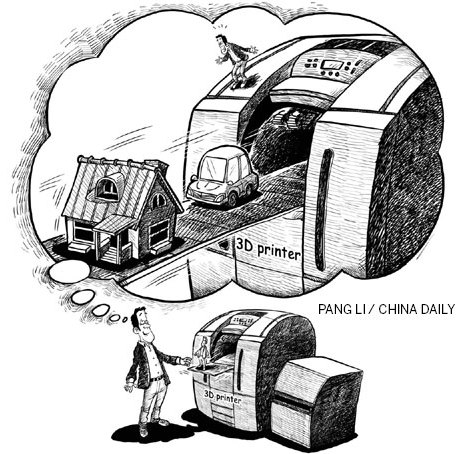'And my next project is to print a house'
Updated: 2013-02-18 10:51
By Wang Ying in Shanghai (China Daily)
|
|||||||||||
|
 |
From furniture to jewelry, from the medical industry to civil engineering, three-dimensional printing can turn all sorts of ideas into tangible objects.
"I wanted to print large objects such as boats but, when I tried different materials, I was most impressed with concrete so I decided to print buildings," said Behrokh Khoshnevis, professor of industrial and systems engineering, aerospace and mechanical engineering and civil and environmental engineering at the University of Southern California.
Khoshnevis said he plans to construct a house in 24 hours by applying 3D printing techniques but he admitted there would be difficulties in meeting his goal.
"For example, if you run out of ink while printing on paper, you will throw that paper away. But you cannot throw half-completed buildings away if your material gets stuck," he said.
Although the printed house is not available to visit, there is a chance for people in Shanghai to see items printed in 3D.
The Belgium-based company Materialise NV is currently holding a 3D printing exhibition in Shanghai that started in late 2012 and will continue until the middle of this year. The company is eager to show Asia what is possible with 3D printing.
"All the pieces shown in the IndustrialRevolution.MGX Exhibition are what cannot be made through traditional manufacturing techniques. A good example of this customization is hearing aids. More than 10 million people already use 3D printed hearing aids, all made according to the size of their ear and customized to their needs," said Wim Michiels, executive vice-president at Materialise NV.
"You can produce anything whenever and wherever you like. If you need one piece or five pieces, it is not a problem. You don't need to set-up production lines for pieces that only need a limited amount of product. Setting up a production line is a lot of work, takes a long time and is very expensive for a limited number of pieces. There is no good return on investment," said Michiels.
Kim Francois, managing director of Materialise China, said while 3D printing is already being used for rapid prototyping in Asia, their European and American clients have already made the next step toward additive manufacturing with small-series production such as hearing aids.
"3D printing technology will cut the cost of making a few pieces of a product because traditionally mass-manufactured goods need a mold first. However, work can start immediately with 3D prints," said Lin Feng, deputy director of the mechanical and engineering department at Tsinghua University.
3D printing will not make any of the current manufacturing processes obsolete but it will make the production of some new products possible. Also, for small batches, this approach will become commonplace so factories and retail outlets will not need to keep large inventories of tools as well as finished products. Production at the point of sale will become a regular practise for certain products, Khoshnevis told China Daily.
wang_ying@chinadaily.com.cn
Related Stories
3D printing reshapes manufacturing 2013-02-18 09:34
3-D printing set to become more mainstream 2012-12-22 07:54
Stocks surge in 3D printing sector 2012-12-19 16:08
3D printing, China's new growth point 2012-12-18 09:25
Handle 3D printing with care 2012-12-07 08:10
Today's Top News
Police continue manhunt for 2nd bombing suspect
H7N9 flu transmission studied
8% growth predicted for Q2
Nuke reactor gets foreign contract
First couple on Time's list of most influential
'Green' awareness levels drop in Beijing
Palace Museum spruces up
Trading channels 'need to broaden'
Hot Topics
Lunar probe , China growth forecasts, Emission rules get tougher, China seen through 'colored lens', International board,
Editor's Picks

|

|

|

|

|

|





